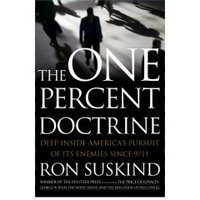
 On Sunday I wrote a post on an excerpt from Ron Suskind’s new book, The One Percent Doctrine that talks about the potential 2003 attack on the NY Subway system that was called off by Ayman Zawahiri. And today Richard Clarke, former White House chief of counter-terrorism said there was reason to be skeptical of the reported incident, indicating that even if it was true it was one of hundreds of threats recorded during Clarke’s tenure.
On Sunday I wrote a post on an excerpt from Ron Suskind’s new book, The One Percent Doctrine that talks about the potential 2003 attack on the NY Subway system that was called off by Ayman Zawahiri. And today Richard Clarke, former White House chief of counter-terrorism said there was reason to be skeptical of the reported incident, indicating that even if it was true it was one of hundreds of threats recorded during Clarke’s tenure."There's reason to be skeptical," said ABC News consultant Richard Clarke, who is the former chief of White House counterterrorism. "Just because something is labeled in an intelligence report does not mean every word in it is true." He said the information describing the plot would have been just one of the hundreds of threats that would have been collected in 2003.
 At the same time, my friend and talented writer Soccer Dad sent me a link to a fascinating article from May 2001, reporting on the trial of four defendants in the bombing of the U.S. embassies in Kenya and Tanzania. The article is well worth a read, especially considering its timing. The basic premise is that, despite locking up these four Al Qaeda operatives, the U.S. had become no safer.
At the same time, my friend and talented writer Soccer Dad sent me a link to a fascinating article from May 2001, reporting on the trial of four defendants in the bombing of the U.S. embassies in Kenya and Tanzania. The article is well worth a read, especially considering its timing. The basic premise is that, despite locking up these four Al Qaeda operatives, the U.S. had become no safer.Unfortunately, the trial does almost nothing to enhance the safety of Americans. The Qaeda group, headed by the notorious Osama bin Laden, which perpetrated the outrages in East Africa, will barely notice the loss of four operatives. Indeed, recent information shows that Al-Qaeda is not only planning new attacks on the U.S. but is also expanding its operational range to countries such as Jordan and Israel.
Perhaps the real importance of the New York trial lies not in the guilty verdicts but in the extraordinary information made public through court exhibits and trial proceedings. These have given us a riveting view onto the shadowy world of Al-Qaeda-though you'd never know from following the news media, for this information was barely reported. Tens of thousands of pages from the trial transcript provide a full and revealing picture of Al-Qaeda, showing it to be the most lethal terrorist organization anywhere in the world.
They demonstrate that Al-Qaeda sees the West in general, and the U.S. in particular, as the ultimate enemy of Islam. Inspired by their victory over the Soviet Union in Afghanistan in the 1980s, the leaders of Al-Qaeda aspire to a similar victory over America, hoping ultimately to bring Islamist rule here. Toward this end, they engaged in many attacks on American targets from 1993 to 1998. One striking piece of information that came out in the trial was bin Laden's possible connection to the World Trade Center bombing in New York in 1993. A terrorist manual introduced as evidence was just an updated version of an earlier manual found in the possession of the World Trade Center defendants.
 So the question that begs to be answered is: what is the value of Suskind’s report on the potential NY subway bombing? Because, even if it is only one of hundreds of potential attacks reported, there is some value in this report.
So the question that begs to be answered is: what is the value of Suskind’s report on the potential NY subway bombing? Because, even if it is only one of hundreds of potential attacks reported, there is some value in this report. Awareness of the tactics of terrorists was growing in England when I lived there. Citizens were paying more attention to their surroundings, and we less shy about notifying officials when seeing unusual activity. As such, more IRA attacks in England were being prevented, and terrorists were being captured, leading to further information on their cells.
Awareness of the tactics of terrorists was growing in England when I lived there. Citizens were paying more attention to their surroundings, and we less shy about notifying officials when seeing unusual activity. As such, more IRA attacks in England were being prevented, and terrorists were being captured, leading to further information on their cells.technorati tags: The One Percent Doctrine, The One Percent Doctrine Ron Suskind, Ron Suskind, Ayman Zawahiri, Richard Clarke, Counter-Terrorism, Subway, 2003, Intelligence, Al Qaeda, Steven Emerson, Daniel Pipes, Kenya, Tanzania, Embassy, bin Laden, Mubtakkar
Posted by Scottage at 7:00 PM / | |